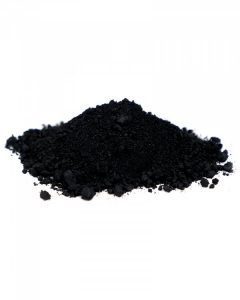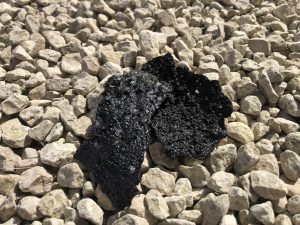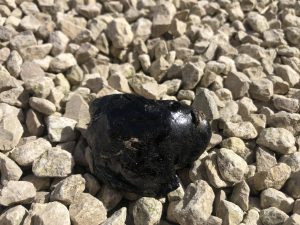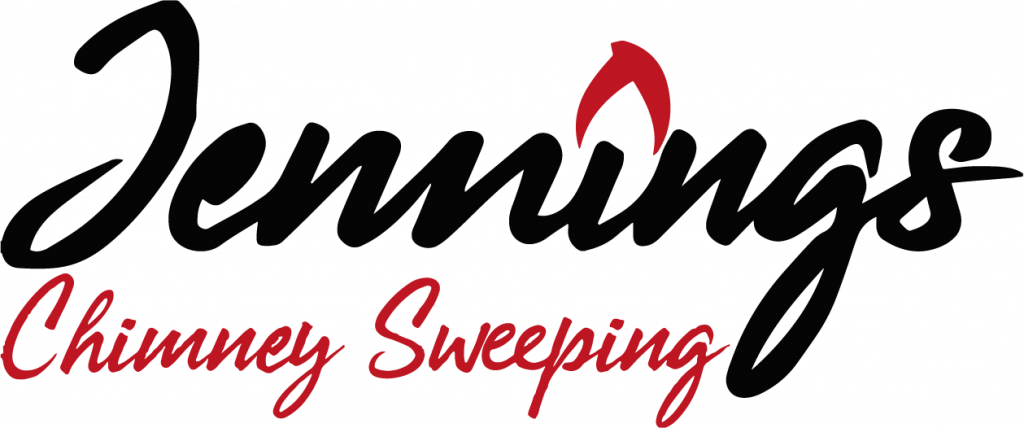Débistrage
Débistrage
Débistrage is the French word referring exclusively to the mechanical removal of tar and/or creosote. By using a variety specialist equipment such as wire whips and in some cases chains, attached to our rotary power sweeping equipment, we are able to remove tougher deposits and build ups, alleviating the fire risk these compounds provide.
Débistrage
Débistrage is the French word referring exclusively to the mechanical removal of tar and/or creosote.
By using a variety specialist equipment such as wire whips and in some cases chains, attached to our rotary power sweeping equipment, we are able to remove tougher deposits and build ups, alleviating the fire risk these compounds provide.

What is the difference between a debistrage and a standard Chimney Sweep
3 stages of Creosote
Creosote is formed when the gases in your fuel cool and condense in the chimney, clinging to the walls. Creosote is a by product of burning wood and is therefore unavoidable. What is avoidable however, is the latter stages of a creosote build up.
Stage 1 - Light fluffy Soot
Stage one creosote is primarily light fluffy soot. Burning nice dry wood and allowing plenty of air into your fire will result in a build up of soot and other light debris. It is flammable but easily removed by your chimney sweep.


Stage 2 - Flakey and brittle
Stage two creosote is formed when the air to your stove is restricted or when burning wood on an open fire where you have minimal control. This results in a ‘smokey’ burn with lower flue temperatures and a sluggish draw in the chimney. These conditions prevent complete combustion of the wood gases, which paired with the sluggish draw, means they do not make it out the chimney. Large amounts of these gases cool and condense forming the thicker, flakey pieces you see in the picture. Stage 2 creosote can often be removed with specialist tools such as a wire loop.

Stage 3 - Glazed creosote/Tar
Stage three creosote is a hard, concentrated fuel and is thus highly flammable. Third stage creosote is created in the same way as second stage, with the conditions simply being more extreme. Once the creosote glazes over to become tar, it becomes very stubborn to remove. Due to it’s highly flammable nature, it is imperative that it is removed from any chimney. This is possible only via a débistrage or a chemical treatment.

The Process
The process of a débistrage is very different that a standard sweep. In standard sweeping, we expect to remove stage one and small amounts of stage 2 creosote. However in a débistrage, we expect to remove stage 3 creosote, and a lot of it!
With the excessive amount of debris removed, it is important to ‘sheet up’ the area appropriately, as a small leak in the seal will result in a room full of airborn debris, which in turn will settle and cover the room in a layer of fine dusts.
In addition to this, the excess debris removed must be appropriately disposed of in Hepa rated and sealed bags.
In terms of the actual mechanical process, a much higher powered drill will be used, much stiffer rods and specialist heads such as flail chains will be used, spun at high speeds to knock off the hardened tar latched onto the brick work.
Following the completion of the débistrage itself, an internal video inspection is carried out to assure that all flammable deposits have been removed.

What is the difference between a debistrage and a standard Chimney Sweep
The 3 stages of Creosote
Creosote is formed when the gases in your fuel cool and condense in the chimney, clinging to the walls.
Creosote is a by-product of burning wood and is therefore unavoidable. What is avoidable however, is the latter stages of a creosote build up.
Light fluffy Soot
Stage one creosote is primarily light fluffy soot. Burning nice dry wood and allowing plenty of air into your fire will result in a build up of soot and other light debris.
It is flammable but easily removed by your chimney sweep.

Flakey and Brittle
Stage two creosote is formed when the air to your stove is restricted or when burning wood on an open fire where you have minimal control. This results in a ‘smokey’ burn with lower flue temperatures and a sluggish draw in the chimney.
These conditions prevent complete combustion of the wood gases, which paired with the sluggish draw, means they do not make it out the chimney. Large amounts of these gases cool and condense forming the thicker, flakey pieces you see in the picture. Stage 2 creosote can often be removed with specialist tools such as a wire loop.

Glazed Creosote / Tar
Stage three creosote is a hard, concentrated fuel and is thus highly flammable. Third stage creosote is created in the same way as second stage, with the conditions simply being more extreme. Once the creosote glazes over to become tar, it becomes very stubborn to remove.
Due to it’s highly flammable nature, it is imperative that it is removed from any chimney. This is possible only via a débistrage or a chemical treatment.

The Process
The process of a débistrage is very different that a standard sweep. In standard sweeping, we expect to remove stage 1 and small amounts of stage 2 creosote. However in a débistrage, we expect to remove stage 3 creosote, and a lot of it!
With the excessive amount of debris removed, it is important to ‘sheet up’ the area appropriately, as a small leak in the seal will result in a room full of airborn debris, which in turn will settle and cover the room in a layer of fine dusts.
In addition to this, the excess debris removed must be appropriately disposed of in Hepa rated and sealed bags.
In terms of the actual mechanical process, a much higher powered drill will be used, much stiffer rods and specialist heads such as flail chains will be used, spun at high speeds to knock off the hardened tar latched onto the brick work.
Following the completion of the débistrage itself, an internal video inspection is carried out to assure that all flammable deposits have been removed.
Due to the nature of open stone and brick chimneys varying drastically in their size, shape and composition, it is not possible to give a ‘one size fits all’ type price for the débistrage process. We have created the calculator below so you can see how much your chimney will cost based on it’s size, in line with our pricing structure.

What is the difference between a debistrage and a standard Chimney Sweep
The 3 stages of Creosote
Creosote is formed when the gases in your fuel cool and condense in the chimney, clinging to the walls.
Creosote is a by-product of burning wood and is therefore unavoidable. What is avoidable however, is the latter stages of a creosote build up.
Light fluffy Soot
Stage one creosote is primarily light fluffy soot. Burning nice dry wood and allowing plenty of air into your fire will result in a build up of soot and other light debris.
It is flammable but easily removed by your chimney sweep.

Flakey and Brittle
Stage two creosote is formed when the air to your stove is restricted or when burning wood on an open fire where you have minimal control. This results in a ‘smokey’ burn with lower flue temperatures and a sluggish draw in the chimney.
These conditions prevent complete combustion of the wood gases, which paired with the sluggish draw, means they do not make it out the chimney. Large amounts of these gases cool and condense forming the thicker, flakey pieces you see in the picture. Stage 2 creosote can often be removed with specialist tools such as a wire loop.

Glazed Creosote / Tar
Stage three creosote is a hard, concentrated fuel and is thus highly flammable. Third stage creosote is created in the same way as second stage, with the conditions simply being more extreme. Once the creosote glazes over to become tar, it becomes very stubborn to remove.
Due to it’s highly flammable nature, it is imperative that it is removed from any chimney. This is possible only via a débistrage or a chemical treatment.

The Process
The process of a débistrage is very different that a standard sweep. In standard sweeping, we expect to remove stage 1 and small amounts of stage 2 creosote. However in a débistrage, we expect to remove stage 3 creosote, and a lot of it!
With the excessive amount of debris removed, it is important to ‘sheet up’ the area appropriately, as a small leak in the seal will result in a room full of airborn debris, which in turn will settle and cover the room in a layer of fine dusts.
In addition to this, the excess debris removed must be appropriately disposed of in Hepa rated and sealed bags.
In terms of the actual mechanical process, a much higher powered drill will be used, much stiffer rods and specialist heads such as flail chains will be used, spun at high speeds to knock off the hardened tar latched onto the brick work.
Following the completion of the débistrage itself, an internal video inspection is carried out to assure that all flammable deposits have been removed.

What is the difference between a debistrage and a standard Chimney Sweep
The 3 stages of Creosote
Creosote is formed when the gases in your fuel cool and condense in the chimney, clinging to the walls.
Creosote is a by-product of burning wood and is therefore unavoidable. What is avoidable however, is the latter stages of a creosote build up.
Light fluffy Soot
Stage one creosote is primarily light fluffy soot. Burning nice dry wood and allowing plenty of air into your fire will result in a build up of soot and other light debris.
It is flammable but easily removed by your chimney sweep.

Flakey and Brittle
Stage two creosote is formed when the air to your stove is restricted or when burning wood on an open fire where you have minimal control. This results in a ‘smokey’ burn with lower flue temperatures and a sluggish draw in the chimney.
These conditions prevent complete combustion of the wood gases, which paired with the sluggish draw, means they do not make it out the chimney. Large amounts of these gases cool and condense forming the thicker, flakey pieces you see in the picture. Stage 2 creosote can often be removed with specialist tools such as a wire loop.

Glazed Creosote / Tar
Stage three creosote is a hard, concentrated fuel and is thus highly flammable. Third stage creosote is created in the same way as second stage, with the conditions simply being more extreme. Once the creosote glazes over to become tar, it becomes very stubborn to remove.
Due to it’s highly flammable nature, it is imperative that it is removed from any chimney. This is possible only via a débistrage or a chemical treatment.

The Process
The process of a débistrage is very different that a standard sweep. In standard sweeping, we expect to remove stage 1 and small amounts of stage 2 creosote. However in a débistrage, we expect to remove stage 3 creosote, and a lot of it!
With the excessive amount of debris removed, it is important to ‘sheet up’ the area appropriately, as a small leak in the seal will result in a room full of airborn debris, which in turn will settle and cover the room in a layer of fine dusts.
In addition to this, the excess debris removed must be appropriately disposed of in Hepa rated and sealed bags.
In terms of the actual mechanical process, a much higher powered drill will be used, much stiffer rods and specialist heads such as flail chains will be used, spun at high speeds to knock off the hardened tar latched onto the brick work.
Following the completion of the débistrage itself, an internal video inspection is carried out to assure that all flammable deposits have been removed.

When is a débistrage required
Stubborn tar deposits
A débistrage may be necessary in a multitude of scenarios. Firstly, if a build up of tar has occurred in your chimney, it must be removed due to how flammable it is. Should stubborn tar deposits still remain in the chimney following having your chimney swept, a débistrage can be a perfect solution to the problem.
Installing an appliance
If a liner is being installed into a previously used chimney, it is vital that the chimney first goes through a débistrage to remove all ancient flammable deposits. Once the liner has been installed with an appliance, future sweeping will commence only in the liner, meaning if any flammable deposits are left in the chimney following the installation, these will be sealed away and will be impossible to clean without removing the liner that’s being installed.
Although future exhaust gasses will be contained in the steel liner, the liner itself will become incredibly hot, which means; If any ancient tar or creosote deposits are left in the previously used chimney, they could catch alight and cause damage to your property.
A liner should never be installed in a chimney that has not had previous deposits removed. We recommend having any installation work done by a chimney professional who will be certain to understand the importance of a débistrage and will either carry it out themselves, or have a fellow chimey professional undertake the work.
Alternatives
In the event that a tar build up has occurred in a liner or in a chimney which is structurally uncertain, a débistrage may not be an appropriate solution as it risks causing damage to stainless steel liners and any existing chimney which is not in perfect condition. Other solutions such as Chemical Tar Removal Treatments may be more appropriate. Your Chimney Sweep will be able to assess your situation and determine which is the best solution for you.

When is a débistrage required
Stubborn tar deposits
A débistrage may be necessary in a multitude of scenarios. Firstly, if a build up of tar has occurred in your chimney, it must be removed due to how flammable it is. A débistrage may be necessary in a multitude of scenarios.
Firstly, if a build up of tar has occurred in your chimney, it must be removed due to how flammable it is. Should stubborn tar deposits still remain in the chimney following having your chimney swept, a débistrage can be a perfect solution to the problem.
Installing an appliance
If a liner is being installed into a previously used chimney, it is vital that the chimney first goes through a débistrage to remove all ancient flammable deposits. Once the liner has been installed with an appliance, future sweeping will commence only in the liner, meaning if any flammable deposits are left in the chimney following the installation, these will be sealed away and will be impossible to clean without removing the liner that’s being installed.
Although future exhaust gasses will be contained in the steel liner, the liner itself will become incredibly hot, which means; If any ancient tar or creosote deposits are left in the previously used chimney, they could catch alight and cause damage to your property.
A liner should never de installed in a chimney that has not had previous deposits removed.

We recommend having any installation work done by a chimney professional who will be certain to understand the importance of a débistrage and will either carry it out themselves, or have a fellow chimey professional undertake the work.
Alternatives
In the event that a tar build up has occurred in a liner or in a chimney which is structurally uncertain, a débistrage may not be an appropriate solution as it risks causing damage to stainless steel liners and any existing chimney which is not in perfect condition.
Other solutions such as Chemical Tar Removal Treatments may be more appropriate. Your Chimney Sweep will be able to assess your situation and determine which is the best solution for you.

When is a débistrage required
Stubborn tar deposits
A débistrage may be necessary in a multitude of scenarios. Firstly, if a build up of tar has occurred in your chimney, it must be removed due to how flammable it is. A débistrage may be necessary in a multitude of scenarios.
Firstly, if a build up of tar has occurred in your chimney, it must be removed due to how flammable it is. Should stubborn tar deposits still remain in the chimney following having your chimney swept, a débistrage can be a perfect solution to the problem.
Installing an appliance
If a liner is being installed into a previously used chimney, it is vital that the chimney first goes through a débistrage to remove all ancient flammable deposits. Once the liner has been installed with an appliance, future sweeping will commence only in the liner, meaning if any flammable deposits are left in the chimney following the installation, these will be sealed away and will be impossible to clean without removing the liner that’s being installed.
Although future exhaust gasses will be contained in the steel liner, the liner itself will become incredibly hot, which means; If any ancient tar or creosote deposits are left in the previously used chimney, they could catch alight and cause damage to your property.

A liner should never de installed in a chimney that has not had previous deposits removed.
We recommend having any installation work done by a chimney professional who will be certain to understand the importance of a débistrage and will either carry it out themselves, or have a fellow chimey professional undertake the work.
Alternatives
In the event that a tar build up has occurred in a liner or in a chimney which is structurally uncertain, a débistrage may not be an appropriate solution as it risks causing damage to stainless steel liners and any existing chimney which is not in perfect condition.
Other solutions such as Chemical Tar Removal Treatments may be more appropriate. Your Chimney Sweep will be able to assess your situation and determine which is the best solution for you.

